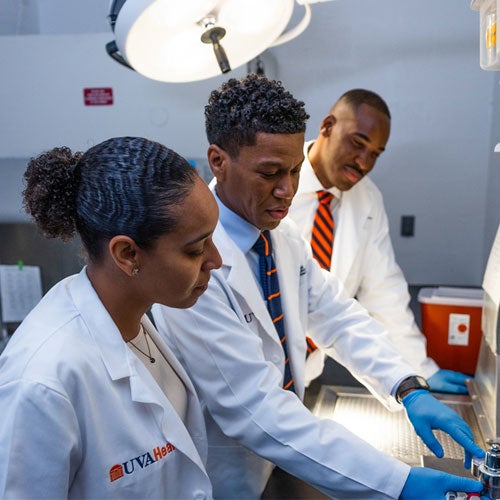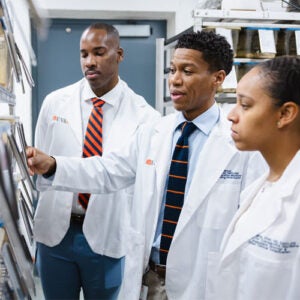
(From left) Toi Collins, DVM, Raphael (Ralph) Malbrue, DVM, Kelvin Moore, DVM
One year ago, the University of Virginia hired Raphael (Ralph) Malbrue, DVM, as the attending veterinarian and director of the Center for Comparative Medicine. He is responsible for animal care and protocols that support innovative research and discoveries at the University, leading to life-saving new treatments for patients.
Dr. Malbrue considers it a privilege to care for the health and well-being of all laboratory animals because research is essential for developing therapies that heal people, like his daughter Violet.
“She was born with a rare genetic disorder called Hyperinsulinism. Through both preclinical animal studies and clinical trials at Congenital Hyperinsulinism Center at the Children’s Hospital of Philadelphia, she was able to be treated and ultimately cured,” shared Dr. Malbrue. He and his whole family are grateful for the effective treatment Violet received and feel obligated to advocate for biomedical research in an effort to help other people facing serious illnesses.
We recently spoke with Dr. Malbrue about his first year at UVA, his new residency program for veterinarians, how the vivaria may grow to support research expansion, and other projects he is passionate about.
Q. Can you describe your role as attending veterinarian and director of the Center for Comparative Medicine?
A. The role as attending veterinarian and director primarily entails responsibility for the health and well-being of all laboratory animals involved in approved ACUC protocols at the University of Virginia. Our program encompasses 10 vivaria, three field stations, an ABSL/BSL-3 facility, gnotobiotic/ germ-free core and veterinary diagnostic center. I like to say the job requires you to wear “three critical hats” — animal advocacy and regulatory compliance, clinical oversight and research support for labs.
Within the Center for Comparative Medicine (CCM), we truly look for innovative ways to balance animal welfare and provide a medium for our researchers to be successful in reaching their scientific goals. Providing that level of support for the University and researchers can range from ensuring the HVAC systems in the numerous vivaria are functioning appropriately to working with an investigator on methods to surgically implant a newly developed medical device. While this might seem like a great charge, it’s one that all CCM team members wear with a badge of honor.
Q. You started your role a little over one year ago; how has your first year gone?
A. The first year has been life changing. I’m grateful to UVA for the unique opportunity and for believing in my vision for the program. I also want to acknowledge those who came before me, such as my predecessor, Sanford Feldman, DMV, for laying such a strong foundation.
With strong support from the Office of the Vice President for Research (OVPR) and the deans and departmental chairs from the various Colleges on Grounds, we’ve been able to grow our staff and organizational chart within the Center. We’ve also been able to enhance our infrastructure within the vivaria to create more space for researchers to conduct their work.
One of our greatest accomplishments is developing a residency program, approved through the American College for Laboratory Animal Medicine-ACLAM, structured to train veterinarians in the specialty of laboratory animal medicine. A program goal is to serve as a beacon of transparency, through public outreach and education, to inform our community about the phenomenal research at UVA. This is supported through an industry partnership with Charles River Laboratories, who provided the University with a generous $1 million gift, which is executed by our Assistant Director of Finance and Administration LeAnn Hopkins.
 Q. Can you tell us more about your new residency program to help train veterinarians to become board-certified laboratory animal veterinarians?
Q. Can you tell us more about your new residency program to help train veterinarians to become board-certified laboratory animal veterinarians?
A. We are very excited to announce that our first resident Kelvin Moore, DMV, started the program in June. This is a huge milestone as we are the first University in the Commonwealth to provide this specific type of postdoctoral training for veterinarians.
There is currently a shortage of laboratory animal veterinarians nationwide, and our ultimate goal is to help strengthen the pipeline. In fact, our Associate Director and Chief Clinical Veterinarian Toi Collins, DVM, has also created an externship/rotation program for pre-veterinary, veterinary and veterinary technician students to help with this initiative. Public outreach is something CCM is very passionate about and we recognize the significant contributions we can make to society through these various initiatives. We are routinely providing tours and presentations for the next generation of scientists and veterinarians working in research.
Q. How does the vivarium need to grow and modernize to accommodate research expansion?
A. We have discussed with leadership the need to develop a vivarium in conjunction with the Paul and Diane Manning Institute of Biotechnology that will allow for flexibility in housing diverse species of research animal populations. New animal models continue to develop supporting translational studies (especially in biotechnology) and we want to be prepared for their arrival.
In all our vivaria, we pride ourselves in providing the absolute best housing conditions for the animals under our care mimicking their natural environments. We understand that good animal care directly equates to good research results and outcomes. I also think the Manning Institute will provide the ability to truly streamline preclinical and clinical research collaborations with the proposed GMP facility and vivarium in such close proximity. This new facility highlights the University’s dedication to the “3 R’s of animal research” — Reduce, Refinement, and Reduction.
Q. What other initiatives have you focused on this first year?
A. It is no secret that over the years some financial barriers have arisen for scientists across the globe. Our Center’s leadership team is investigating several innovative methods to provide cost savings for researchers. These initiatives have been led by our Assistant Director of Finance and Administration LeAnn Hopkins, with support from the Office of the Vice President for Research (OVPR).
One project we’re excited to have completed is the development of a Veterinary Comparative Pathology & Diagnostic Laboratory. Recently, we hired Samantha St. Jean, DVM, a board-certified veterinary pathologist, to oversee this operation. Her services, including animal pathology consultation, histology slide review and necropsies, are at no additional cost for researchers. To date, she has saved researchers nearly $30,000 and counting in just a few months. This also highlights the University’s and the OVPR’s strategic planning goals to build a stronger research support infrastructure for scientists at UVA. Being fiscally responsible is something we all take very seriously as a public state institution entrusted with federal funding.
